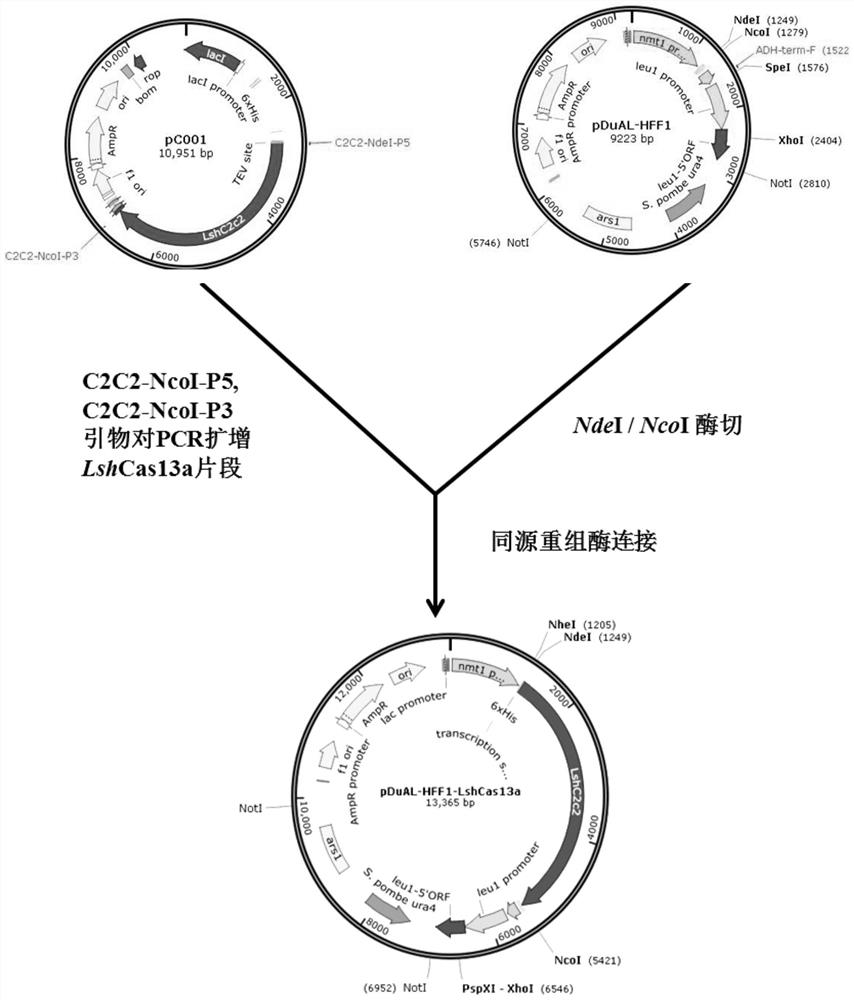Technology for intervening and blocking virus reverse transcription transposition based on CRISPR-Cas13a
A technology of retrotransposition and reverse transcription, applied in the field of virology, can solve the problem of lack of test models for detecting retroviruses
- Summary
- Abstract
- Description
- Claims
- Application Information
AI Technical Summary
Problems solved by technology
Method used
Image
Examples
Embodiment 1
[0083] Embodiment 1, expression CRISPR-Cas13a protein in eukaryotic cell
[0084] The establishment of the cell expression system expressing CRISPR-Cas13a protein, and the method for expressing CRISPR-Cas13a protein in eukaryotic cells are as follows:
[0085] 1. Construct the vector pDUAL-HFF1-LshCas13a expressing LshCas13a protein
[0086] Such as figure 1 As shown, use C2C2-NcoI-P5 (sequence is TATGCATCACCACCATCATCATCATATGGGGAACCTGTTCGGACACAAG (SEQ ID NO: 1)) and C2C2-NcoI-P3 primer (sequence is TCATCGTCGTCCTTGTAGTCCATGGTTACAGGGTATCGTTAGTATTCT (SEQ ID NO: 2)) to carry out PCR amplification, from the pC001 plasmid Amplify the LshCas13a coding sequence fragment; insert it into the pDUAL-HFF1 plasmid to obtain the recombinant plasmid pDUAL-HFF1-LshCas13a.
[0087] 2. Plasmid transformation
[0088] Linearize pDUAL-HFF1-LshCas13a and transform the linearized fragment into fission yeast. Using the lithium acetate / PEG / heat shock method, 500ng of linear pDUAL-HFF1-LshCas13a fr...
Embodiment 2
[0091] Embodiment 2, expressing the gRNA targeting the CRISPR-Cas13a of the retrotransposon Tf1 RNA intermediate in eukaryotic cells
[0092] After repeated research, the inventors optimized the gRNA targeting the Tf1 RNA intermediate, targeting the Gag gene of Tf1, the gene sequence is as follows (SEQ ID NO: 12):
[0093] 5’-atgaaaaactcatcacagaaaagaattcgaatggatggaaatggtggatattgtactcaagatgatatttcagatatccttaagcattttgtaaatcaaaccacccgccatgtggaaacgtatagaaaaggcatggatatggaagagttcatcgttaaattaagaacattttttggtgaacattccgatagatattcaactgaacagtctaaaagactgtacgctatagaacgacttgaatcaagagatcaaaattatgctaataaaatcttttgtcaagattcttctcttacttgggatgaact a ttaagaagaatggtaaacctagttggatctgatgaagaagaaaggttgactaa a acctttttgaaacttaagaatgataaggacaaggtactattcattaagaaagtactctatgaagataatttaagtgagaaacgagtcagattatatctactatggatgcttccaccctatctgattaaacagagaggtgattcttactgggacatggataaaaatatagacaagatttttaactttgtaccagataaaggtgaaacgataattgaacgctacaccaaacctaggaatcttttaaaaacaaagactggaagcaattggaaaaacaataagtttttaaaggagaacgacac...
Embodiment 3
[0112] Example 3, CRISPR-Cas13a interferes with retrotransposon Tf1RNA intermediate effect test in eukaryotic cells such as fission yeast
[0113] In this example, the above-mentioned established model system based on CRISPR-Cas13a intervention to block viral retrotransposition was used to verify the effect of interfering with transposition.
[0114] The experimental operation steps are as follows:
[0115] 1. On the MM+thiamine (Thiamine; 10 μM) plate, culture the transgenic fission yeast cells (3 types in total) established in the preceding examples that integrate the expression of LshCas13a protein and free expression of gRNA-Tf1 plasmid, and cultivate them at 32° C. for 4 days. Thiamine can inhibit the transposition of Tf1 initiated by nmt1 promoter.
[0116] 2. Qualitative determination of transposition activity of retrotransposon Tf1
[0117] (1) Pick a single clone from the MM+Thiamine plate, streak it onto the PMG+Thiamine (10μM) plate and incubate for 3 days;
[01...
PUM
 Login to View More
Login to View More Abstract
Description
Claims
Application Information
 Login to View More
Login to View More - Generate Ideas
- Intellectual Property
- Life Sciences
- Materials
- Tech Scout
- Unparalleled Data Quality
- Higher Quality Content
- 60% Fewer Hallucinations
Browse by: Latest US Patents, China's latest patents, Technical Efficacy Thesaurus, Application Domain, Technology Topic, Popular Technical Reports.
© 2025 PatSnap. All rights reserved.Legal|Privacy policy|Modern Slavery Act Transparency Statement|Sitemap|About US| Contact US: help@patsnap.com



